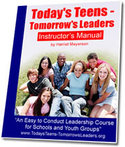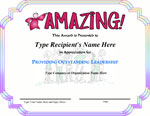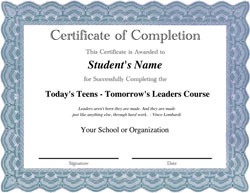
Here’s how to get started today teaching a teen leadership course for your junior high and high school students. What’s more, you can do it in a way that is both easy for you and fun for the students.
If you are a teacher, youth group leader, or home school parent, you can use this information to teach your first class today.
Most teachers choose teaching as a career because they “want to make a difference” in the lives of their students. Teaching a teen leadership course will make that difference.
Our youth are diamonds in the rough ready and eager to be polished into brilliant, valuable, and unique leaders in their schools, communities, and future workplaces. You can do the polishing.
The 4 Most Important Questions about Teaching a Teen Leadership Course
- How many students should be in a leadership class?
- How should the class be set up?
- How much time will it take?
- What leadership skills should I teach?
The answer to all of these questions are two words – It depends!
Number of students for your teen leadership course…
The optimal class size ranges from 5 – 20.
Smaller classes don’t give them as much interaction with other students. However, it is better to teach a group of 2-4 than not teach it all.
For example, in some schools the guidance counselors hold small group leadership sessions.
Of course, you can have larger classes, but it will be difficult to give the kids the attention they need without additional help.
You can ask a volunteer parent or another teacher to help out with your teen leadership classes.
In fact, even if you are teaching less than 20 it would be helpful to have an assistant. It also makes it more fun to have another adult to enjoy the student’s as they make progress with their leadership skills.
Class setup for your teen leadership course…
Divide students into groups of 4-6
Teenagers learn best when they interact with others. Therefore, they should be divided in groups or teams of 4-6 students for most of the exercises.
Sitting around tables is best. However, if you don’t have tables, you can still seat students in groups.
Even if you are in a school auditorium seated theater style, you can have a group of 4 students form a team and interact together.
How much time will your teen leadership course take?
Teaching the basic leadership skills will take about 2 0-30 classroom hours depending on the number of students you have.
Of course, if you have less time, you should still teach as much as you can in the time you have. It’s better to teach some leadership skills than none at all.
Obviously, the more time you have, the more material you can cover, and the more in-depth you can get in your discussions. You can be flexible in creating your own schedule.
Here are different types of schedules that teachers, recreation centers, youth groups, and summer camps have used with our “Today’s Teens – Tomorrow’s Leaders” Curriculum .
Schools
- One 45 – 60 minute teen leadership class a week for a semester or a year.
- One 45 – 60 minute teen leadership class a day for 4-6 weeks
- One or more teen leadership all day sessions spread throughout the year.
Camps, Youth Groups and Recreation Centers
- One week all day teen leadership course
- Two week half day course
- One week half day course
- Weekend retreats
The Top 7 Leadership Skills to Teach Teens
Obviously there are many more than 7 leadership skills, and if you have the time, you can choose additional skills to add to your teen leadership course curriculum.
However, these 7 skills are essential for leaders , so be sure to include them in your teen leadership course.
Sample Exercises
In this article, there is one sample exercise for each of these 7 lessons so you can get started right away teaching your teen leadership classes.
You can get a complete curriculum including:
- Step-by-step lesson plans
- Downloadable Instructor’s Manual
- Downloadable Student Workbooks
- Tons of additional exercises and resources
in our Today’s Teens – Tomorrow’s Leaders Instructor’s Center.

Choose a leader for each group.
When doing the exercises each group should choose a leader to record their group’s discussion to share with the class. Leaders should be rotated so that each student has a chance to be a leader.
A word of caution. Refrain from talking about current political leaders when teaching your leadership classes, and ask your students to do the same.
Skill #1. Qualities of a Leader
Here are some of th e qualities that you can discuss in your leadership classes. You and your students can add to this list.
- Honesty
- Integrity
- Flexibility
- Enthusiasm
- Good judgement
- Persistence
- Positive attitude
- Inspiring
- Willingness to serve others,
- Trustworthy
Qualities of a Leader Exercise:
Ask each group of students to think of a leader and make a list of leadership qualities that person has. The ir group leader then shares what they discussed with the group.
Skill #2. Public Speaking Skills
Obviously public speaking is an essential part of being a leader. Public speaking skills can be taught by having students present several 2-3 minute speeches , and then discuss the positive aspects of each speech with the class.
Public speaking skills to teach
- Eye Contact
- Movement
- Gestures
- Vocal Variety
- The use of props and visual aids
- Interacting with the audience
TIP: Focus on the positive aspects of the speech as teens are very sensitive to criticism. For example : after the speech ask the student, “How do you feel about your speech?” Next, ask the class, “What did you like about John’s speech?”
Public Speaking Exercise:
Each student gives a 1-2 minute “Getting to Know You” speech about their favorite food, hobby, school subject, movie, etc., and end with what they hope to learn from the teen leadership class.
Skill #3. Leadership Confidence
People will only follow leaders who ha ve self-confidence, who believe in themselves and their vision. So, one of the important things students need to learn in your teen leadership course is how to develop self-confidence.
Everyone is looking at “You… the Leader” to see how much you believe in yourself.
Teens are at an age when they want to conform to the group. However, one of the ways confidence is built is by each person valuing his or her own uniqueness.
Honestly, the teenage years are difficult, and it takes courage for teens to build their confidence.
Because leadership confidence is so important, we have many additional confidence building exercises in our Today’s Teens – Tomorrow’s Leaders curriculum.
Leadership Confidence Exercise:
In their groups have student share their uniquness in these areas:
- Personal interests
- skills
- Family
- Culture
- Physical appearance
- Past experiences
Each group then selects one member of the group to share his or her story with the rest of the class. If you have time, then it’s be neficial for everyone to share with the class.
Skill #4. Vision, Mission, and Planning
Leaders need to have a vision and turn that vision into reality by planning. They also need to learn how to brainstorm for ideas, plan their project and delegat e tasks.
Vision, Mission, and Planning Exercise:
Each group creates an idea for a school event, and then shares their vision with the rest of the class . This should include how they will get the money needed, a detailed plan to carry out th eir vision , and how they will delegate tasks.
Skill #5. Listening Skills
One of the most important things leaders can do is to listen to their followers. Yet, most people are more interested in talking than in listening.
The truth is that everyone has their own thoughts going on in their heads while listening to others. Because of this, they don’t give all of their attention to what they are hearing.
A leader has to learn to stop their own inner thoughts and focus 100% on what someone is saying so that person feels listened to.
Good listening skills include:
- Eye contact
- Appropriate response
- Being able to reflect what the person talking to him is feeling in a conversational way.
Listening Skills Exercise:
One of the important ways that a person feels listened to and respected is by eye contact. This exercise has 3 steps.
Step1: Students get into pairs and talk to their partner about a favorite vacation or hobby for 30 seconds without eye contact. They have to either look down or somewhere else in the room, but not at their partner.
Step2: They have the exact same conversation using good eye contact for 30 seconds.
Step 3: They they discuss how they felt about each conversation with the class.
Skill #6. Building Trust
This is an essential skill because leaders cannot lead people who don’t trust them.
Here are some skills you can teach teens to get people to trust them.
- Be dependable . Do what you say you are going to do.
- Be consist an t in the way you d o things and deal with people.
- Have a special ability or skill that is necessary for the group you are leading.
- Have integrity . Do the right thing, even when nobody’s looking.
Building Trust Exercise
Ask students in their groups to tell their story about an experience they had with someone who is trustworthy and someone who was not trustworthy, and how they felt during each experience.
Next, each group selects one from their group to share their trustworthy experience and someone to share their untrustworthy experience with the class. Then discuss with the class the things that build trust.
Skill #7. Understanding Personality Styles
Communicating with others is such an essential leadership skill because that is how you inspire people to follow you. The good news is that communication skills can be learned.
It’s obvious that people have different personalities. It is a lot less overwhelming to teens when they learn about different personality styles and how to best deal with each of them.
While nobody exactly fits into one category, if a major part of a person’s personality fits a category, it is easier to learn how to talk with them.
There are many assessments that divide people into 4 categories. Each company’s assessment has it’s own method and styles. In the Today’s Teens – Tomorrow’s Leaders curriculum we use the following categories when teaching teens.
The 4 Personality Styles
1. Relater – Likes close personal relationships and is warm and caring. Tends to be indirect in dealing with others.
2. Socializer – Likes being involved with others. Can exaggerate and generalize. Is excitable and impatient. Is open and direct in dealing with others.
3. Thinker – Is task oriented. Doesn’t like involvement. Is cautious and works slowly. Likes a lot of details. Is a private person.
4. Director – Likes to be in charge , makes quick decisions , active and competitive. Can be overbearing. Is direct in dealing with people.
Understanding Personality Styles Activity:
Designate each corner of the room as a different personality type and ask the students to go to the corner that they think best fits them.
Then, have each group talk to the students in their group to see if they think the others fit the category.
Then discuss how the groups differ, the benefits of each, and how you have to talk differently to different types of people.
Encouraging Your Stud ents
Since students in junior high and high school are very sensitive about criticism you should find positive ways to applaud their progress during each session.
During the session when someone does something you like, reward that person with praise. At the end of each session tell the students what you liked about what they did. Praise the students for their efforts and you will be rewarded with more effort from them.

In our “Today’s Teens – Tomorrow’s Leaders” Instructor’s Center we have downloadable progress certificates that you can award your students not only for their efforts, but also for their attitudes.
Graduating from Leadership Class
Your graduation ceremony will be the highlight of your teen leadership course as your students get rewarded for their efforts. You can invite parents or other students in the school to listen to their leadership speeches watch with pride as they get their graduation certificates.
In our Today’s Teens – Tomorrow’s Leaders Instructor’s Center we have the entire teen leadership course curriculum and a downloadable “Certificate of Completion” to award to students on Graduation Day.

A certificate is something they can display with pride for their efforts. They can also list the leadership training in their college applications and when applying for jobs.
- In conclusi on
You can make a difference in the life of teens and help them become youth leaders in their schools, and, as they grow into adults, leaders in their workplaces and communities.
For more information about our Today’s Teens – Tomorrow’s Leaders teen leadership course curriculum, I invite you to download our free report, “Easy Ways to Teach Leadership Skills to Teens.”